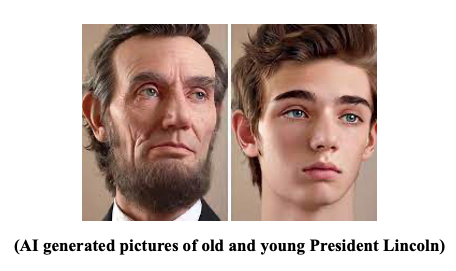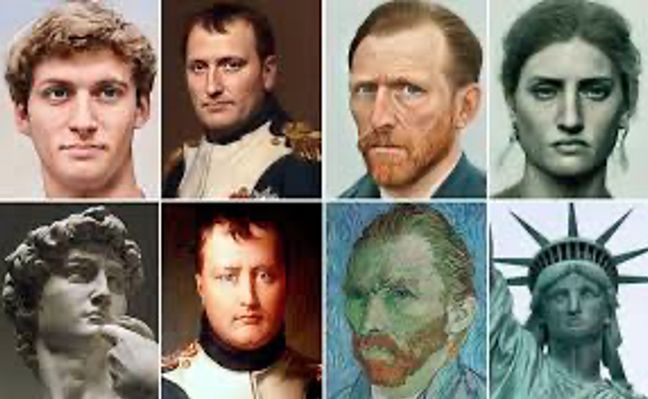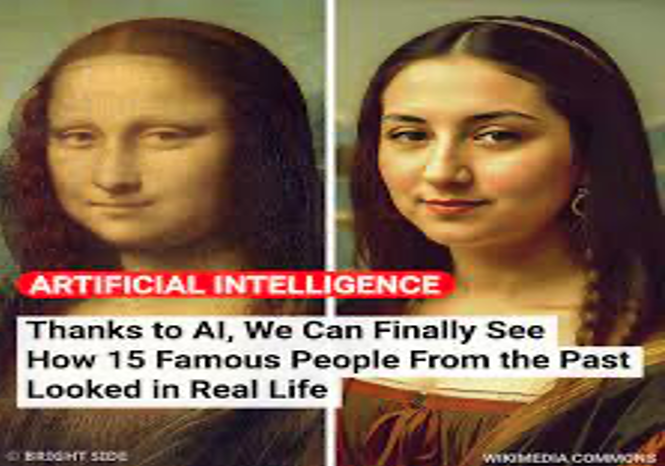 Artificial intelligence (AI) is one of the most rapidly expanding technologies in human history. It is also a disruptive technology that can do harm as well as good. An emerging use of artificial intelligence will be for politics and government operations.
Artificial intelligence (AI) is one of the most rapidly expanding technologies in human history. It is also a disruptive technology that can do harm as well as good. An emerging use of artificial intelligence will be for politics and government operations.
Fairly soon AI generated images of politicians and elected officials, combined with their actual voices, can be used to create “avatars” that could speak and answer questions. Primarily the avatars would be used after business hours and on weekends, but it might be possible to use the avatars 24 hours a day 7 days a week as a first introduction to the politicians or officials. During business hours the avatars could answer phones or emails and then route the callers to live staff personnel, or to the actual politicians themselves if the callers are important.
NOTE: The AI tool Google Bard was used for fact checking but not for writing text. The illustrations were all produced by artificial intelligence. The text was written by the author without use of AI tools.
POLITICAL CANDIDATES AND ELECTED OFFICIALS USE OF ARTIFICIAL INTELLIGENCE (AI)
Before getting to the main topic of using artificial intelligence for political campaigns and government operations, it is useful to identify some of the available AI tools. Readers should check frequently because new AI tools are being created rapidly.
Examples of Free Artificial Intelligence Tools as of 2023
ChatGPT Probably the most widely used AI tool.
Google Bard Popular with Google email users
FOTOR AI Used for images and art creation.
Jasper AI Used for text and document content.
Photosonic Used for AI art and images
Artbreeder Used for AI art and images
Bing Image Creator Used for AI art and images.
Readers should check the latest tools for generating pictures with artificial intelligence.
Artificial Intelligence in 2023 for Politics and Government Operations
In July of 2022 and article by Bruce Schneiner and Nathan Sands in the MIT Technology Review discussed six milestones for artificial intelligence in politics and government:
Milestone 1 Acceptance of AI draft bills by legislatures.
Milestone 2 Adoption of a law drafted by AI.
Milestone 3 AI political messages receive high approval scores.
Milestone 4 AI develops a new and successful policy for a government.
Milestone 5 AI increases campaign contributions.
Milestone 6 AI drafts a law that is accepted across state or regional boundaries.
Basic uses of artificial intelligence by all political candidates would be to use a tool such as Google Bard or ChatGPT to ask questions about important issues for voters. For national elections the questions might involve global warming or the war between Russia and Ukraine.
For local elections the questions might be incorporation of Siesta Key or repairs on local highways.
It would also be possible to query AI tools about voter opinions of opposing candidates or to ask AI search tools about what issues such as important topics for local elections, i.e. concerns about higher taxes, concerns about education, or concerns about traffic on Siesta Key, or about building large hotels on Siesta Key.
Using Artificial Intelligence During Political Campaigns
It is now possible for political candidates and elected officials to create AI avatars that use their actual faces and voices on political websites. The avatars would be able to answer questions and provide information to voters and even to political reporters. The avatars would be able to operate 24 hours a day 7 days a week although no doubt humans would be available during normal business hours.
The avatars should identify themselves as AI creations in order not to deceive voters. The candidates or elected officials could provide position statements for the avatars, but the avatars could also use their considerable research powers to deal with questions outside the immediate messages provided by the candidates. Following are some pictures of sample artificial intelligence avatars:
Questions that the avatars might answer include “what is your opinion on global warming” or “what is your opinion on the war between Russia and the Ukraine.” Local issues such as “when will repairs be completed on Route 41 near Sarasota” or what are your views on building large new hotels on Siesta Key. Any topic of interest can be used with artificial intelligence avatars.ble.
The avatars would also tell human voters that their questions would be given to the actual candidates or officials during normal business hours.
A clearer picture of an avatar shows only a single face that is remarkably realistic:
Another advantage of AI for politicians and elected officials would be instantaneous statistical analysis of the questions and topics that are important to the voters that called in. The AI tool could provide the candidates and their staff with daily statistics on questions by topic.
Already in 2023 artificial intelligence is being used for many State political campaigns often to attack opposing candidates. Eventually new laws will need to be passed to keep AI from disrupting politics.
Campaign staff could use several AI tools such as Google Bard or ChatGPT for daily queries about voter feelings on election issues. Almost certainly AI will become a standard tool for political campaigns before the elections of 2024.
EXAMPLES OF REALISTIC ARTIFICIAL INTELLIGENCE CREATED IMAGES
Following is a large picture of an AI generated face that looks real but was created by a computer:
Following are pictures of six human faces created by an AI tool:
They are shown here to illustrate how realistic AI images can appear. Toe a casual observer all six faces look like real people.
Following a photo of Sandra Bullock on the left and an AI replica of the photo on the right:
The next picture shows an AI generated image of President Kennedy:
Already in 2023 Republicans created an unflattering picture of President Biden using AI to provide a negative message and there is also an AI-generated picture of former President Trump showing him in jail and wearing a prison jump suit. In the future AI will soon become both a political tool for candidates and a political weapon for opposing candidates.
The political candidates’ actual voices could be used for responses to telephone queries. If the questions are submitted to a candidate’s or official’s web site via a computer, the AI engine that is responding should have no difficulty in understanding the questions.
But if the questions come in by phone to a special phone number provided by the candidate or official, there may sometimes be difficulties if the speaker has a heavy accent such as a Russian accent or a Spanish accent.
For geographic locations with a significant number of voters with different ethnic backgrounds, the AI avatar would be able to respond in multiple languages: English, Spanish, French, etc.
Fairly soon artificial intelligence will become a new political tool for candidates and a new political weapon for opposing candidates.
Not only politicians and candidates will use avatars, but also non-profit associations such as the following:
Candidates for Using Artificial Intelligence for Customer Service After Normal Hours
- Alumni Associations such as the University of Florida
- Author associations such as the Author’s Guild
- Bar Associations for lawyers
- Chambers of Commerce
- Clubs such as Rotary Club or Kiwanis
- Condominium Associations for larger condos
- Historical Associations such as the Florida Historical Society
- Labor Associations and Labor Unions
- Medical Associations
- Veterans Associations
- Siesta Key Association and other municipal organizations
An avatar for a condominium association would feature the faces and voices of officers of the condo board of directors. Owners could ask questions late at night or on weekends, and the condo AI tool could provide useful information based on questions such as the contact information for local plumbers, air-conditioning repairs services, and other local services such as transportation to airports, food delivery services, and other nearby condominium office phone numbers. Artificial intelligence will soon become a general tool for information of all kinds at all hours of day and night.
In case of actual emergencies late at night such as a burst water pipe, the AI tool could notify both the actual condo officers, and also emergency services such as fire departments or police.
Examples of Faces Generated by Artificial Intelligence
Shown below are AI generated pictures of famous people and statues:
In the picture above the AI-generated image is shown on the top row, and the original illustrations are on the bottom row. For example the face above the Statue of Liberty represents what a model might have looked like.
Following is what the Mona Lisa might have looked like as a real person:
AI can generate pictures of anyone whose image has been on a website. AI can also duplicate the voices of anyone who has ever had a speech or song recorded and placed on a website.
Next is a picture of William Shakespeare in a modern sports shirt:
Next is a picture of George Washington:
The final historical pictures is of Benjamin Franklin:
The author is distantly related to President James Buchanan. Following is an AI-generated picture of President Buchanan:
The ability of AI to generate realistic images from ancient statues and portraits is interesting. Buit the ability of AI to duplicate real people and also imitate their voices is going to be a major issue for political candidates and government officials from now on.
Recent Fake Political Photographs Generated by Artificial Intelligence
As of 2023 it appears that the dominant use of AI in politics is for politicians to create images of competitive politicians that are unflattering such as the AI-generated pictures of former President Trump being arrested:
Unfortunately, AI pictures are so realistic in appearance that they could easily deceive viewers who did not know the true source.
The next series shows a series of famous world leaders dressed as gangsters, starting with former President Clinton:
The next picture shows former President Obama as a gangster:
The next photo shows Vladimir Puttin in the same generic gangster outfit:
These photos are so realistic that unless they were clearly identified as AI fakes any reader would be deceived.
The next picture shows North Korean Leader Kim Jong In wearing the same gangster outfit:
If readers saw the pictures individually, they might be deceived, but seeing a whole series demonstrates the ability of AI to generate realistic fakes.
Additional Pictures of U.S. Presidents Created by Artificial Intelligence
The next image was apparently created in Florida and shows pictures of former President Trump with other famous people:
Major companies that run ads such as Google have started a new requirement that any ad that has been modified by artificial intelligence must clearly state that that the AD is not a real image. Fairly soon it will be necessary to create new State and Federal laws that govern the use of AI for fake advertising in order to protect both politicians and voters from false visual and audio information.
Recommendations about Artificial Intelligence for Politicians in 2023
The recommendations for politicians in 2023 are divided into three major segments: 1) Using AI to benefit your campaign; 2) monitoring ads and broadcasts by political rivals to be sure that they are not using AI to damage your campaign; 3) Using AI to explore the most important issues with local voters by querying AI tools.
Because politicians may not be computer experts, they should seek advice from supporters who do know about computers such as local computer science professors or employees of companies such as IBM and Microsoft.
In Sarasota, Florida the Sarasota Technology Users Group (STUG) has over 100 members. There are also computer science faculty at New College of Sarasota.
Although there would be some expense involved, candidates should consider whether to create AI tools such as avatars to benefit their campaigns.
The use of Avatars would probably be too expensive for local elections such as for county commissioners but may be worthwhile for State and Congressional candidates such as state representatives or the U.S. Congress.
If any candidate or staff member thinks that opposition candidates are using artificial intelligence to harm their campaign, then complaints should be filed with election officials and possibly even law enforcement, although in 2023 there are not many laws passed covering artificial intelligence disinformation.
However, in September of 2023 a bi-partisan committee has started to formulate new Federal laws to keep artificial intelligence from harming elections. The members who are proposing the legislation are Amu Klobucher, John Hawley, Chris Coors, and Susan Collins. If new laws are passed before the next election that would benefit America.
SUMMARY OF BENEFICIAL AND HARMFUL USES OF ARTIFICIAL INTELLIGENCE
Future Beneficial Uses for Artificial Intelligence
- Urban traffic controls and rerouting drivers away from blockages
- Routing emergency vehicles to fastest routes
- Continuous medical monitoring of medical patients
- Converting books into television shows and movies
- Military threat recognition and target acquisition
- Pilotless combat aircraft
- Pilotless reconnaissance drones
- Torpedo guidance and target seeking
- Building protection systems using night cameras and motion sensing
- AI lectures at high school and university levels
- Providing 24-hour a day support for political campaigns and government offices
- Allowing political staff to explore issues of importance to local voters.
Dangerous and Criminal Uses of Artificial Intelligence
- Telephone scams by imitating human voices based on tapping telephone calls
- E-mail scams that imitate friends and family
- Computer scams that seek banking and personal information
- Spy satellites and spy balloons
- Creating imitations of famous art or fashion designs and passing them as originals
- Imitating voices of friends or colleagues in order to steal or get personal information
- Password guessing
- Fake news reports
- Targeted phishing
- Fake websites that offer low-cost items
- Using fake AI images and voices to damage political rivals before elections.
- Using fake AI-generated polls to support a candidate.
The most important hazard is the use of AI for criminal activities. If a person is well known and has photos on the web and any recordings of his or her voice, criminals could construct a virtual replica of the person and use it for extortion or theft. It would easily be possible to have a phony AI replica place a telephone call to a relative or friend and ask for money.
Hopefully major software research companies such as IBM or Microsoft will be able to develop methods or tools that can detect whether a phone call is coming from an actual human or an imitation created by AI. Until then millions of people are at risk from potential scams created by criminals using AI.
It will also be necessary to pass new State and Federal laws governing the use of artificial intelligence for deceptive purposes. If creating distorted images using AI of rival politicians were a criminal offense, then unscrupulous politicians would be prevented from the harm that is happening in 2023. Fortunately, a bilateral Federal commission has already started to draft protective legislation about artificial intelligence frauds.
RECENT REPORT AND ARTICLES ON ARTIFICIAL INTELLIGENCE
Six Milestones for AI in Politics MIT Technology Review July 2022
Five Ways Artificial Intelligence will Change the World NBC News 2023
The Future of AI’s Impact on Society MIT Technology Review 2023
How Will AI Impact the Future of Work Forbes 2023
Artificial Intelligence News Science Daily 2023
Artificial Intelligence (AI) Technology The Guardian 2023
Artificial Intelligence BBC News 2023
BOOKS ABOUT ARTIFICIAL INTELLIGENCE
The McGraw Hill Illustrated Encyclopedia of Robotics and Artificial Intelligence, McGraw Hill 2022.
Fundamental of Artificial Intelligence: Problem Solving and Automated Reasoning; Miroslav Kubert, McGraw Hill, 2023
The Essence of Artificial Intelligence; Alison Crowly, Prentice Hall; 2023
Philosophy & Artificial Intelligence; Todd C. Moody; Prentice Hall 2023
Artificial Intelligence: A Modern Approach; Stuart Russel and Peter Norvig; Pearson; 2022
Readings on Software and Technical Educational Changes
Starr, Paul; The Social Transformation of American Medicine; Basic Books; Perseus Group; 1982; ISBN 0-465-07834-2. NOTE: This book won a Pulitzer Prize in 1982 and is highly recommended as a guide for improving both professional education and professional status. There is much of value for the software community.
Strassmann, Paul; Information Payoff; Information Economics Press, Stamford, Ct; 1985.
Strassmann, Paul; Governance of Information Management: The Concept of an Information Constitution; 2nd edition; (eBook); Information Economics Press, Stamford, Ct; 2004.
Strassmann, Paul; Information Productivity; Information Economics Press, Stamford, Ct; 1999.
Weinberg, Gerald M.; The Psychology of Computer Programming; Van Nostrand Reinhold, New York; 1971; ISBN 0-442-29264-3; 288 pages.
Weinberg, Gerald M; Becoming a Technical Leader; Dorset House; New York; 1986; ISBN 0-932633-02-1; 284 pages.
Yourdon, Ed; Death March – The Complete Software Developer’s Guide to Surviving “Mission Impossible” Projects; Prentice Hall PTR, Upper Saddle River, NJ; ISBN 0-13-748310-4; 1997; 218 pages.
Author’s Books on Risk from 1978 to 2022
- Software Development Patterns and Anti-Patterns; Taylor Francis, 2022
- The Technical and Social History of Software Engineering; Addison Wesley, 2013
- Quantifying Software – Global and Industry Perspectives; CRC Press, 2012
- The Economics of Software Quality, Prentice Hall, 2011
- Software Engineering Best Practices; McGraw Hill, 2009.
- Software Assessments, Benchmarks, and Best Practices; Addison Wesley Longman, Boston, Ma; 2000
- The Year 2000 Software Problem, Addison Wesley Longman, Boston, MA; 1998.
- Software Quality – Analysis and Guidelines for Success (International Thomson Computer Press; Boston, MA; 1997).
- Patterns of Software System Failure and Success; International Thomson Computer Press: Boston, MA; 1995).
- Assessment and Control of Software Risks; Prentice Hall, Englewood Cliffs, NJ; 1994.
- Software Quality Today; IBM Corporation; 1978
- Software Engineering Best Practices; IBM Corporation 1978
Sample of Author’s Journal Articles on Risks
More than 200 journal articles between 1978 and 2023 in magazines such as Scientific American, IBM Systems Journal, Datamation, Crosstalk, IEEE Transactions on Software Engineering, Cutter Software Journal, and others. This list shows a sample of one article per year even though several might have been published in the same year. Some of the titles include:
- “High Efficiency Defect Removal Efficiency”; IEEE Software; August 2019
- “Challenges of Software Project Management”; IEEE Computer; June 2017”
- “Corporate Software Risk Reduction”; ITT Journal; August 2016
- “Defenses Against Software Litigation”; IEEE Computer; March 2015
- Software Benchmark Analysis”; IEEE Software; June 2014
- “Software Measurement Errors”; IEEE Software; December 2012
- “Software Quality Economics”; IEEE Software; January 2011
- “Economics of Software Outsourcing”; Datamation; November 2010
- “Quality Control for Embedded Software”; IEEE Computer, May 2009.
- “Preventing Software Failure: Problems Noted in Breach of Contract Lawsuits”; U.S. Air Force software journal Crosstalk, June 2008.
- “Software Defect Potentials”; Crosstalk, Air Force Technology Support Center; December 2007
- “Social and Technical Reasons for Software Project Failure”; Crosstalk; Air Force Technology Support Center, June 2006.
- “Software Engineering State of the Art”; IEEE Software; February 2005.
- “The Evolution of Defense Software”; Crosstalk; Air Force Technology Support Center; November 2004
- “Conflict and Litigation between Software Clients and Developers”; IEEE Computer; April 2001.
- “Analysis of Damages due to the Y2K Problem”; IEEE Software; December 2000.
- “Sizing Up Software”; Scientific American Magazine; December 191 (1978).
CAPERS JONES’ GOVERNMENT CLIENTS FOR RISK CONSULTING
The author was an international risk consultant for IBM and his own company Namcook Analytics. He has consulted about risks with over 60 government agencies at International, Federal, and State levels. He has consulted with about 95 corporations such as Apple, AT&T, Ford, General Motors, and Microsoft. A sample of 25 government agencies is shown here:
- Atomic Energy Commission (AEC)
- Civil Service Commission
- Department of Defense (DoD)
- Homeland Security
- Internal Revenue Service (IRS)
- National Aeronautics and Space Administration (NASA)
- National Security Agency (NSA)
- Office of the Surgeon General
- S. Airforce
- S. Navy
- Government of Canada
- Government of Hong Kong
- Government of Japan
- Government of Malaysia
- Government of Singapore
- Government of South Korea
- Government of Quebec
- Government of Thailand
- State of California
- State of Florida
- State of New York
- State of Oregon
- State of Pennsylvania
- State of Rhode Island
- State of South Carolin
The author has consulted about risks with about 95 corporations and universities. This sample shows only 25 corporations and universities.
SAMPLE OF CAPERS JONES CORPORATE AND ACADEMIC CLIENTS
- American Airlines
- Amdahl
- American Express
- Apple
- AT&T
- Bank of America
- Boeing
- Dunn & Bradstreet
- Dupont
- Ford
- General Motors
- Grumman
- Hartford Insurance
- Harvard University
- IBM
- McKinsey Consulting
- Microsoft
- MIT
- Mobil Oil
- Nippon Electric
- Raytheon
- Walt Disney
- Wells Fargo
- Westinghouse
- Xerox



















